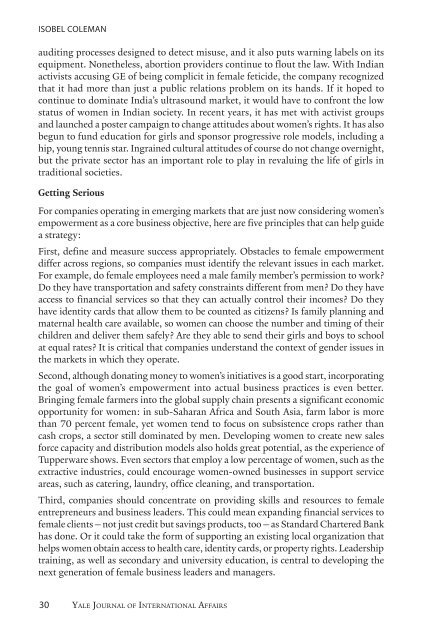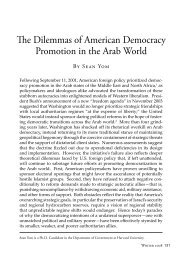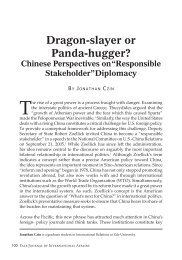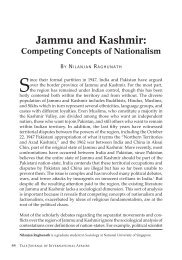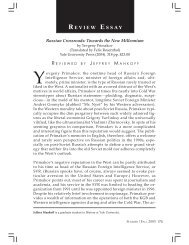Women and the Global Economy - Yale Journal of International Affairs
Women and the Global Economy - Yale Journal of International Affairs
Women and the Global Economy - Yale Journal of International Affairs
You also want an ePaper? Increase the reach of your titles
YUMPU automatically turns print PDFs into web optimized ePapers that Google loves.
ISOBEL COLEMAN<br />
auditing processes designed to detect misuse, <strong>and</strong> it also puts warning labels on its<br />
equipment. None<strong>the</strong>less, abortion providers continue to flout <strong>the</strong> law. With Indian<br />
activists accusing GE <strong>of</strong> being complicit in female feticide, <strong>the</strong> company recognized<br />
that it had more than just a public relations problem on its h<strong>and</strong>s. If it hoped to<br />
continue to dominate India’s ultrasound market, it would have to confront <strong>the</strong> low<br />
status <strong>of</strong> women in Indian society. In recent years, it has met with activist groups<br />
<strong>and</strong> launched a poster campaign to change attitudes about women’s rights. It has also<br />
begun to fund education for girls <strong>and</strong> sponsor progressive role models, including a<br />
hip, young tennis star. Ingrained cultural attitudes <strong>of</strong> course do not change overnight,<br />
but <strong>the</strong> private sector has an important role to play in revaluing <strong>the</strong> life <strong>of</strong> girls in<br />
traditional societies.<br />
Getting Serious<br />
For companies operating in emerging markets that are just now considering women’s<br />
empowerment as a core business objective, here are five principles that can help guide<br />
a strategy:<br />
First, define <strong>and</strong> measure success appropriately. Obstacles to female empowerment<br />
differ across regions, so companies must identify <strong>the</strong> relevant issues in each market.<br />
For example, do female employees need a male family member’s permission to work<br />
Do <strong>the</strong>y have transportation <strong>and</strong> safety constraints different from men Do <strong>the</strong>y have<br />
access to financial services so that <strong>the</strong>y can actually control <strong>the</strong>ir incomes Do <strong>the</strong>y<br />
have identity cards that allow <strong>the</strong>m to be counted as citizens Is family planning <strong>and</strong><br />
maternal health care available, so women can choose <strong>the</strong> number <strong>and</strong> timing <strong>of</strong> <strong>the</strong>ir<br />
children <strong>and</strong> deliver <strong>the</strong>m safely Are <strong>the</strong>y able to send <strong>the</strong>ir girls <strong>and</strong> boys to school<br />
at equal rates It is critical that companies underst<strong>and</strong> <strong>the</strong> context <strong>of</strong> gender issues in<br />
<strong>the</strong> markets in which <strong>the</strong>y operate.<br />
Second, although donating money to women’s initiatives is a good start, incorporating<br />
<strong>the</strong> goal <strong>of</strong> women’s empowerment into actual business practices is even better.<br />
Bringing female farmers into <strong>the</strong> global supply chain presents a significant economic<br />
opportunity for women: in sub-Saharan Africa <strong>and</strong> South Asia, farm labor is more<br />
than 70 percent female, yet women tend to focus on subsistence crops ra<strong>the</strong>r than<br />
cash crops, a sector still dominated by men. Developing women to create new sales<br />
force capacity <strong>and</strong> distribution models also holds great potential, as <strong>the</strong> experience <strong>of</strong><br />
Tupperware shows. Even sectors that employ a low percentage <strong>of</strong> women, such as <strong>the</strong><br />
extractive industries, could encourage women-owned businesses in support service<br />
areas, such as catering, laundry, <strong>of</strong>fice cleaning, <strong>and</strong> transportation.<br />
Third, companies should concentrate on providing skills <strong>and</strong> resources to female<br />
entrepreneurs <strong>and</strong> business leaders. This could mean exp<strong>and</strong>ing financial services to<br />
female clients—not just credit but savings products, too—as St<strong>and</strong>ard Chartered Bank<br />
has done. Or it could take <strong>the</strong> form <strong>of</strong> supporting an existing local organization that<br />
helps women obtain access to health care, identity cards, or property rights. Leadership<br />
training, as well as secondary <strong>and</strong> university education, is central to developing <strong>the</strong><br />
next generation <strong>of</strong> female business leaders <strong>and</strong> managers.<br />
30 <strong>Yale</strong> <strong>Journal</strong> <strong>of</strong> <strong>International</strong> <strong>Affairs</strong>


